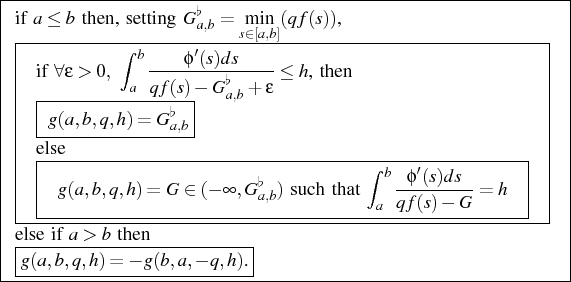|
|
|
[Contents] | [Index] |
Collaborator: J. Fuhrmann, K. Gärtner
Cooperation with: R. Eymard (Université de Marne-la-Vallée, Champs-sur-Marne, France)
Description:
We propose a new method to compute the numerical flux of a finite volume scheme, used for the approximation of the solution of the nonlinear partial differential equation
in a 1D, 2D or 3D domain ![]() .
.
Here,
![]()
![]() C1(
C1(![]() ,
,![]() d) is such that
div
d) is such that
div![]() = 0.
Furthermore, we assume
= 0.
Furthermore, we assume
![]()
![]() C1(
C1(![]() d,
d,![]() d) to be
Lipschitz
continuous and strictly monotonically increasing, and
f
d) to be
Lipschitz
continuous and strictly monotonically increasing, and
f ![]() C0(
C0(![]() d,
d,![]() d).
d).
The method is based on the solution of the nonlinear elliptic two-point boundary value problem
where q is the normal projection of
We define a function
g(a, b, q, h) by setting its value to the constant
value
- [![]() (v(x))]' + qf (v(x)) for all x
(v(x))]' + qf (v(x)) for all x ![]() (0, h) for given
a, b, q, h.
(0, h) for given
a, b, q, h.
This function then is used to describe the numerical flux between two adjacent control volumes in a finite volume method, where a, b are the values of this solution in the adjacent control volumes.
We prove the existence of a solution to this two-point boundary value problem. We show that the expression for the numerical flux can be yielded without referring to this solution. Furthermore, we prove that the so designed finite volume scheme has the expected stability properties and that its solution converges to the weak solution of the continuous problem.
We have proven that the value of g(a, b, q, h) is given by the following relation:

This approach generalizes known discretization schemes like the Scharfetter-Gummel scheme to the nonlinear case.
Except in special cases, the calculation of the numerical fluxes
involves the solution of nonlinear equations.
To illustrate the method, we take
![]() = (0, 1),
= (0, 1),
![]() : s
: s ![]() s2,
f : s
s2,
f : s ![]() s,
q
s,
q ![]() [0, +
[0, + ![]() ), the initial value u0 = 0.
For a given
v
), the initial value u0 = 0.
For a given
v ![]() (q, +
(q, + ![]() ), we use the boundary conditions at x = 0
), we use the boundary conditions at x = 0
![]() (0, t) = (v - q)vt/2 and
set
(0, t) = (v - q)vt/2 and
set
![]() (1, t) = 0 for t < 1/v and
(1, t) = 0 for t < 1/v and
![]() (1, t) = (v - q)(vt - 1)/2, otherwise.
(1, t) = (v - q)(vt - 1)/2, otherwise.
The unique weak solution of this problem is then given by

![\makeatletter
\@ZweiProjektbilderNocap[h]{0.47\textwidth}{fb04_fg3_fvol_1}{fb04_fg3_fvol_2}
\makeatother](img249.gif) |
References:
|
|
|
[Contents] | [Index] |